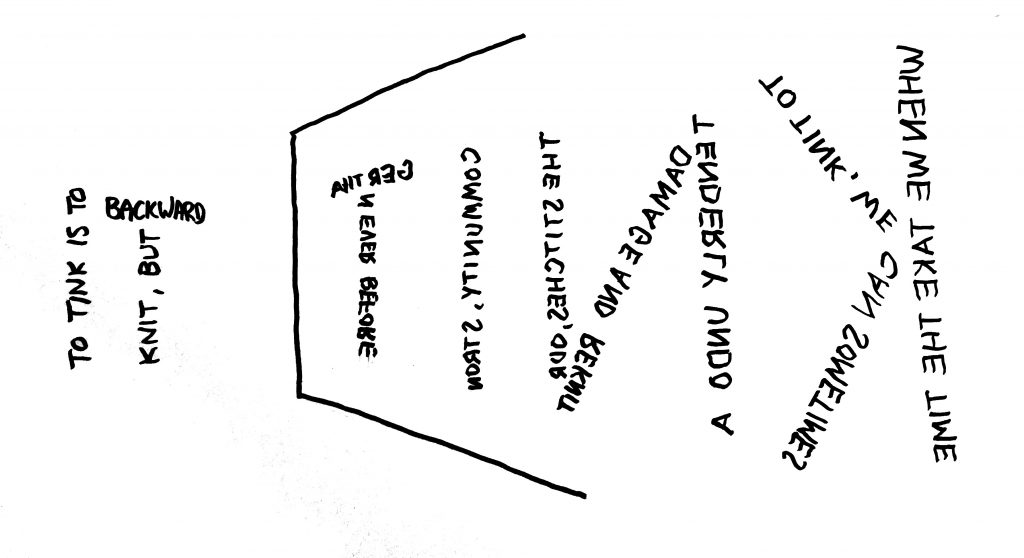Hello! We’re still in a Pandemic here!
Stay Home and TINK!
People often bring projects to me with stitches falling here and there. They know something’s wrong but they are too afraid to face it themselves. I beg them to remember to always first STOP the BLEEDING people! With knitting, this means finding something to put in a dropping stitch so it doesn’t get worse. This applies to so much, not just dropping stitches or actual blood. Because many of us aren’t very resilient and need to learn some survival skills, and not just CPR (which is awesome and necessary) but emotional first aid, too.
When someone or something is bleeding, we can’t get all mired up in who or what went wrong in whatever situation at first. Instead we need to notice and hear that someone or something is experiencing harm and tend to that need first. We can figure out blame and, more importantly, accountability, later. In this moment, we sometimes have to grab whatever is available to us to stop the harm. In relationships and community, sometimes that’s just our own ears and taking the time to Listen with Intention and Pay Attention.
But sometimes the mistake or harm done isn’t immediately noticeable. Sometimes we’re happily knitting along through life and we glance down at our work and, horror of horrors, we realize we’ve made a mistake. And not just a singular mistake, but we’re completely off pattern. We haven’t been paying attention. Damn that show we’ve been binge watching that’s so engrossing!
Realizing we’ve been doing it all wrong-all along–well that’s not a good feeling to sit with. The dominant culture promotes perfectionism, but we’re humans and we’re going to make mistakes. The question is are we going to admit to them? face them? and attempt to repair them – or make reparations as needed?
When I teach my Survival Skills for Knitting class, I remind folx to remember that first we have our EYES (and the BRAINS behind them) to look at our work and diagnose the problem. The first skill everyone should learn is the ability to NAME something. If you can’t name a problem, if you can’t recognize your mistake then of course you can’t figure out how to fix it. So first you have to REALLY LOOK. And not just – it seems like something’s wrong here. But get closer, get proximate. How are things connected? How are they not connected?
Often the best way to do this in knitting, is to TINK. To “TINK” is literally just the word KNIT backwards. And that’s what it means, to knit backwards, to undo each stitch one by one.
Tinking each stitch is like retracing your steps, a Ctrl Z of undoing… if only we could do that with harmful words and actions… But we can only begin to remedy the negative impact of harmful stuff when we take the time to actually see that there is a problem and peel back to see what that problem is. Go back and look for the bump in the road where we fell down. We can’t accept responsibility or even begin to repair something if we don’t at first recognize a problem even exists.
Only when we take the time to TINK can we find where we got off pattern. To find where, when, and how trust was broken or the moment we forgot to value someone else as much as ourselves, our own profit, power, or prestige.
Tinking a project, a situation, a relationship, allows us to go back and name the problem or at least visualize where something has gone wrong. When we take the time to tink, we can sometimes tenderly undo a damage and reknit the stitches–our relationships, our community– into something stronger and more resilient than ever.

Possible Questions/Further Thoughts to Explore
What do you know about emotional first aid? Perhaps consider doing some research and/or bringing a trainer to your group or community or participate/organize in an online training.
How do we “stop the bleeding” when it comes to situations with other people? Even if you haven’t had Emotional First Aid training, what can you imagine might be meaningful things to do when it becomes apparent that someone is being harmed by a situation or the behavior (words or actions) of yourself or others? Explore together with others some situations that have come up that they have been witness or active participant in when something happened and they observed someone intervening in a meaningful way or even a more harmful way. What did they learn? How would they do things differently? How could the harm have been prevented from the beginning? Don’t just focus on extreme situations – i.e. when someone is being violent towards another (which is also a really important thing to explore – especially as we hopefully are all trying to consider alternatives to calling the police) but when verbal abuse and/or micro aggressions are happening — what can people witnessing do? and what can the verbal abuser or micro aggressor (who might be you/ourselves) do when they are confronted with their behavior?
Tinking is undoing, stitch by stitch, to find where things went wrong. How can we do that in meaningful ways in our relationships? in our groups, congregations, work places, and community?
